The Bottom Line
Introduction, Drive Specifications, Pricing and Availability
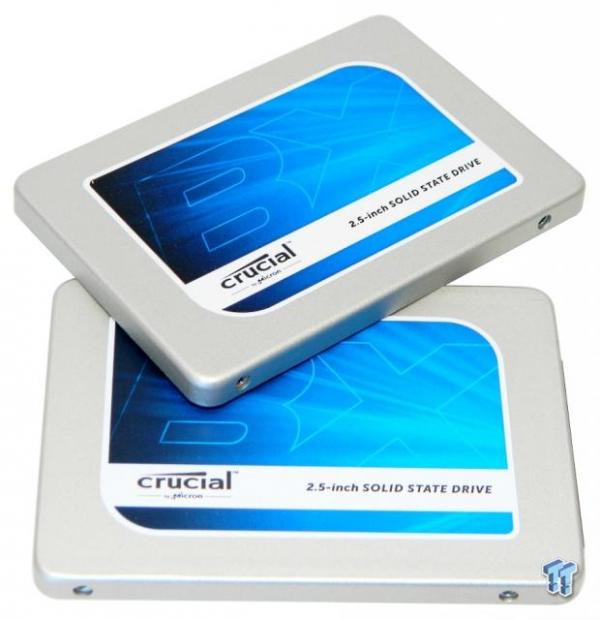
Crucial has a reputation for high-performance SSDs. Crucial's MX200 and BX100 are both top performers in their class. Looking to further penetrate the value segment, Crucial has launched a new line of cost-effective SSDs designated BX200. The BX200 differs from the rest of Crucial's SSD portfolio in that this is their first TLC (Triple Level Cell) flash powered SSD. Micron recently introduced their 16nm TLC flash to market and Crucial's BX200 is the first consumer SSD built on Micron 16nm TLC flash technology.
Micron's 16nm MLC flash has been wildly successful, finding its way into more value based SSDs than any other flash on the market. 16nm MLC flash has proven to be a fantastic performer despite its low cost. This is a recipe for success in the universe of solid state storage. Price wars have contributed to the mainstream adoption of SSDs, and as pricing continues to drop, the way forward is more cost effective TLC flash.
Micron has thrown their hat into the ring with the launch of the BX200. TLC flash allows manufacturers to offer larger capacity SSDs at a lower cost. On the face of it, this sounds great, but is it? Capacity is nice, and an increase is something we all want. So far the problem with non-Samsung TLC flash continues to be very poor sustained write performance. So you get more gigabytes per dollar with TLC flash, but that comes at the expense of overall performance.
To augment the typically terrible write performance of TLC flash, SSD purveyors have turned to programming a portion of the drive's flash array to operate as SLC (Single Level Cell). Implementing a pseudo SLC caching layer on a TLC based drive allows a TLC based SSD to deliver good write performance in short bursts. Of course, manufacturers of TLC based drives want to present their products in the best light possible, and as such, list TLC SSDs write performance inside the drives SLC caching layer, with the omnipresent "up to" disclaimer attached. After all, they don't want to say that their TLC SSD actually writes at speeds below that of some platter HDDs when writes occur outside the drive's caching layer. To be fair, most writes in a typical OS setting will be small enough to fall within a TLC drive's SLC caching layer, but there will be times when the inferior performance of planar TLC flash will disappoint.
When looking at TLC vs. MLC and whether or not TLC makes sense for you, there is only one factor to consider - pricing. Recently we have had a wave of poor performing TLC-based SSDs come across our bench, and not only has the performance of these drives been lousy, pricing has been nearly that of MLC-based SSDs. To date, we've seen no compelling reason to go with a TLC based SSD over MLC with the lone exception of the 850 EVO. We believe the highest price that makes sense for a planar TLC based SSD would be about 66% the cost of the lowest priced MLC SSD to adequately compensate for inferior performance. Up to this point, the pricing of planar TLC SSDs has been way too high for our liking when you factor in performance. Why would you not go with MLC flash for just a few more dollars?
Will the BX200 be able to join the 850 EVO as a viable alternative to MLC-based SSDs? Let's take a look.
The BX200 480 and 960GB SATA III SSDs ship with a plastic spacer and downloadable cloning software, making the transition from an HDD to an SSD easy for first timers. Crucial's BX200 480GB SATA III 2.5" SSD is currently retailing for $129.99 at Amazon. Crucial's BX200 960GB SATA III 2.5" SSD is currently retailing for $299.99 at Amazon.
Specifications: Crucial BX200 480GB & 960GB SATA III SSD

Specifications for the 480GB BX200 are identical to the 960GB model. The BX200 SATA III 2.5" x 7mm FF SSD is available in three capacities: 240GB, 480GB, and 960GB. Performance for both larger capacities is listed at 540 MB/s sequential read and 490 MB/s sequential write. Random performance is not given. Crucial backs the BX200 with an industry standard three-year warranty. No TBW is given, but one is implied.
Drive Details
Crucial BX200 480GB & 960GB SATA III SSD
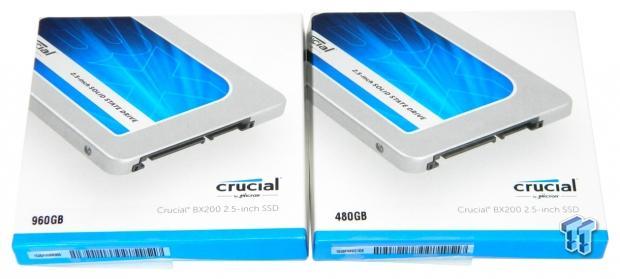
The BX200 retails in white and blue colored packaging. The front of the box features an image of the enclosed drive; capacity is listed as well.
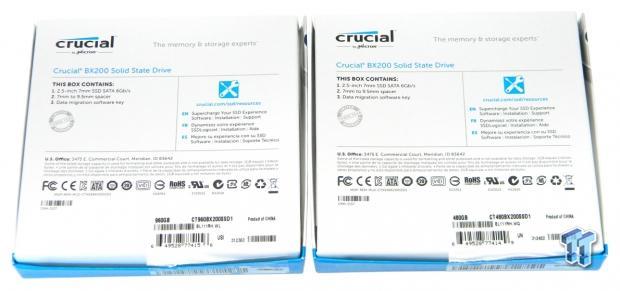
The rear of the packaging lists the drives 2.5" x 7mm form factor, SATA 6Gb/s interface, included spacer, and downloadable data migration software.
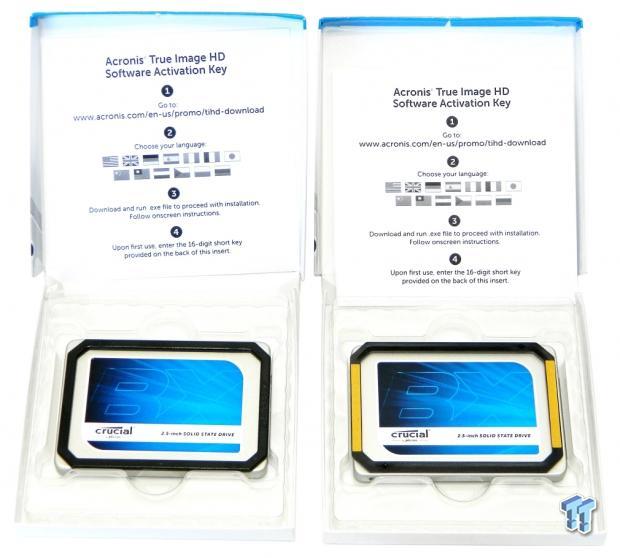
Contained within the packaging is the drive itself, plastic spacer and a key to activate the included Acronis True Image migration software.
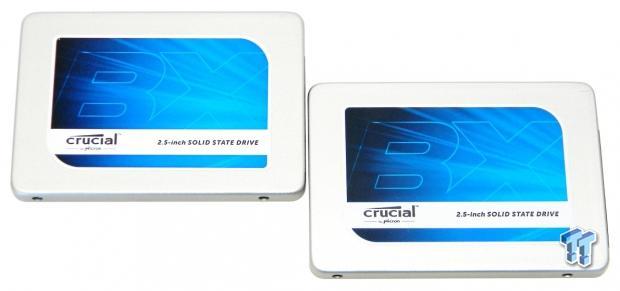
The front of the drives natural colored aluminum enclosure features an attractive blue and silver manufacturer's label.
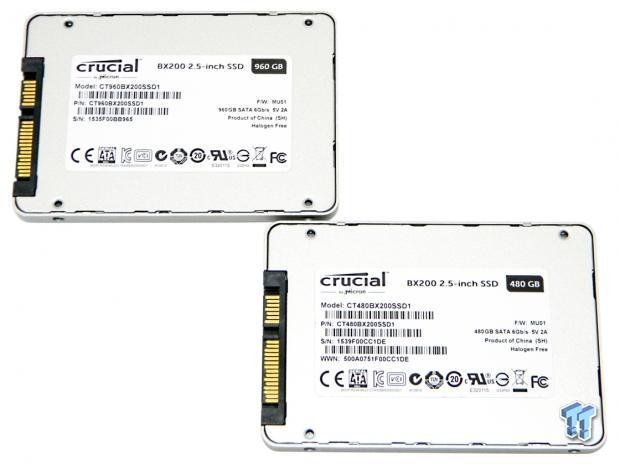
The back half of the drive's aluminum enclosure has a manufacturer label that lists the drive's model number, serial number, shipping firmware, and other relevant information.
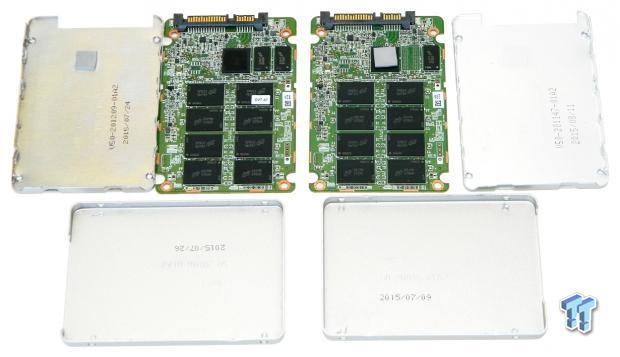
The drive's full-length PCB snaps into place. The entire enclosure is a screw-less design that is very hard to open without bending the sheet aluminum.
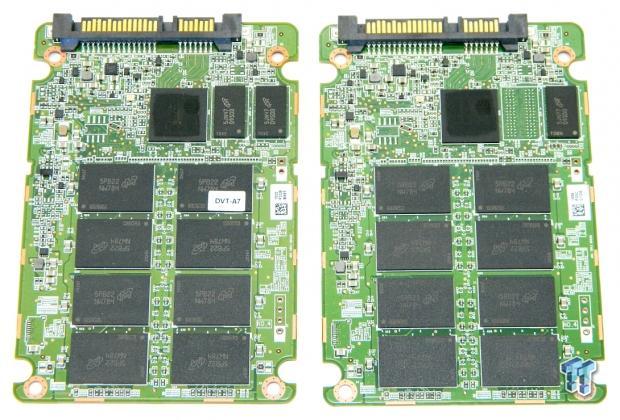
The drive's SM2256 controller, eight flash packages, and DRAM cache package/s are located on this side of the full-length PCB.
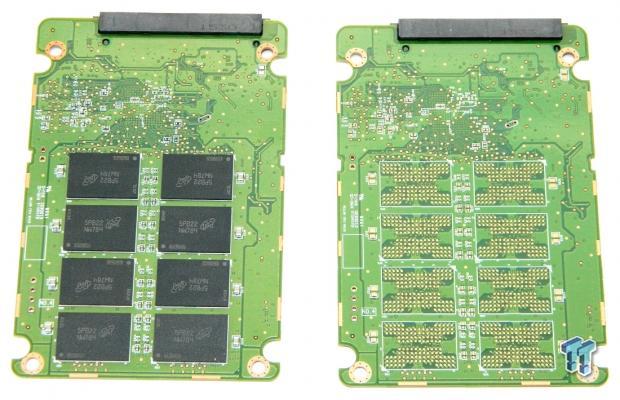
The 960GB model has an additional eight flash packages located on this side of the PCB.
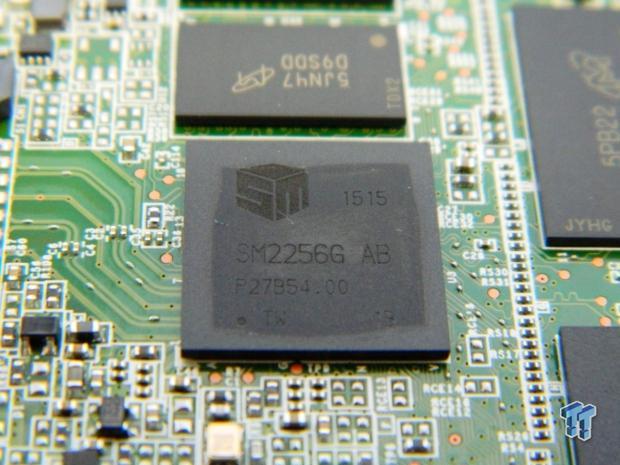
A close-in view of the 4-channel Silicon Motion SM2256 controller that powers the BX200.

A close-in view of the drive's 16nm TLC flash packages.
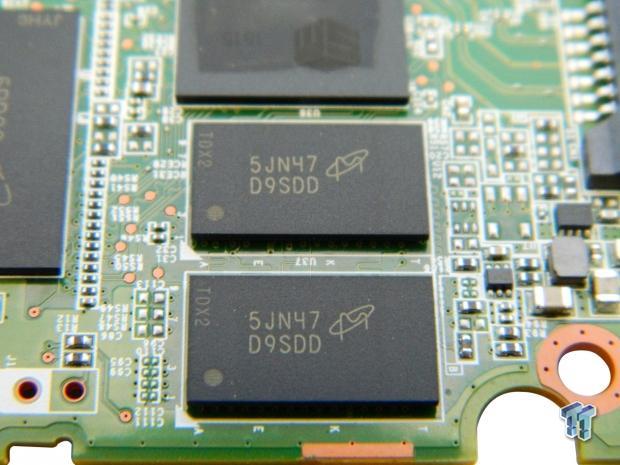
A close-in view of the drive's Micron DDR3 DRAM cache package/s.
Test System Setup and Properties
Jon's Consumer SSD Review Test System Specifications
- Motherboard: ASRock Extreme9 Z97 - Buy from Amazon
- CPU: Intel Core i7 4790K @ 4.8GHz - Buy from Amazon / Read our review
- Cooler: Swiftech H2O-320 Edge - Buy from Amazon / Read our review
- Memory: Corsair Dominator DDR3 32GB 2400MHz - Buy from Amazon
- Video Card: Onboard Video
- Case: IN WIN X-Frame - Buy from Amazon / Read our review
- Power Supply: Seasonic Platinum 1000 Watt Modular - Buy from Amazon / Read our review
- OS: Microsoft Windows 10 Professional 64-bit - Buy from Amazon
- Drivers: Intel RAID option ROM version 13.0.0.2075 and Intel RST driver version 13.6.0.1002
We would like to thank ASRock, Crucial, Intel, Corsair, RamCity, IN WIN, and Seasonic for making our test system possible.
Drive Properties
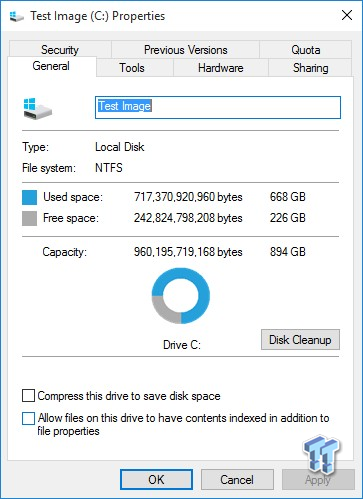
The majority of our testing is performed with our test drive as our boot volume. Our boot volume is 75% full for all OS Disk "C" drive testing to replicate a typical consumer OS volume implementation. We feel that most of you will be utilizing your SSDs for your boot volume and that presenting you with results from an OS volume is more relevant than presenting you with empty secondary volume results.
System settings: Cstates and Speed stepping are both disabled in our systems BIOS. Windows High-Performance power plan is enabled. Windows write caching is enabled, and Windows buffer flushing is disabled. We are utilizing Windows 10 Pro 64-bit OS for all of our testing except for our MOP (Maxed-Out Performance) benchmarks where we switch to Windows Server 2008 R2 64-bit.
Synthetic Benchmarks - ATTO & Anvil Storage Utilities
ATTO
Version and / or Patch Used: 2.47
ATTO is a timeless benchmark used to provide manufacturers with data used for marketing storage products.
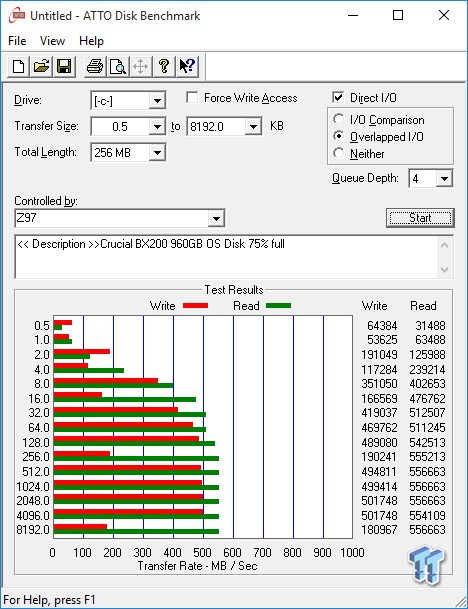
Sequential read/write transfers max out at 556/501 MB/s. Keep in mind this is our OS volume 75% full. Write performance displays a lot of variability.
Sequential Write

Sequential write performance with the drive loaded up with data displays a saw tooth pattern; not what we want to see.
Sequential Read
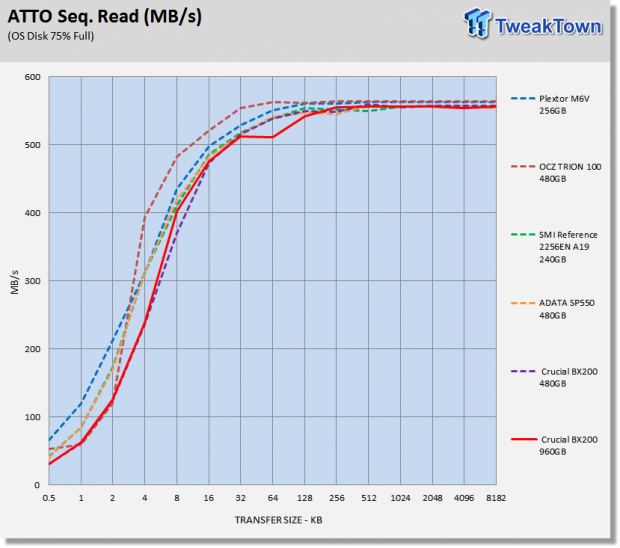
Sequential read performance looks quite good.
Anvil Storage Utilities
Version and / or Patch Used: 1.1.0
Anvil's Storage Utilities is a storage benchmark designed to measure the storage performance of SSDs. The Standard Storage Benchmark performs a series of tests; you can run a full test or just the read or write test, or you can run a single test, i.e. 4k QD16.
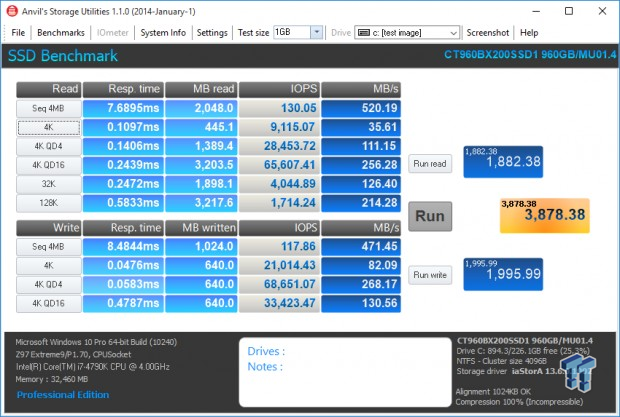
Scoring
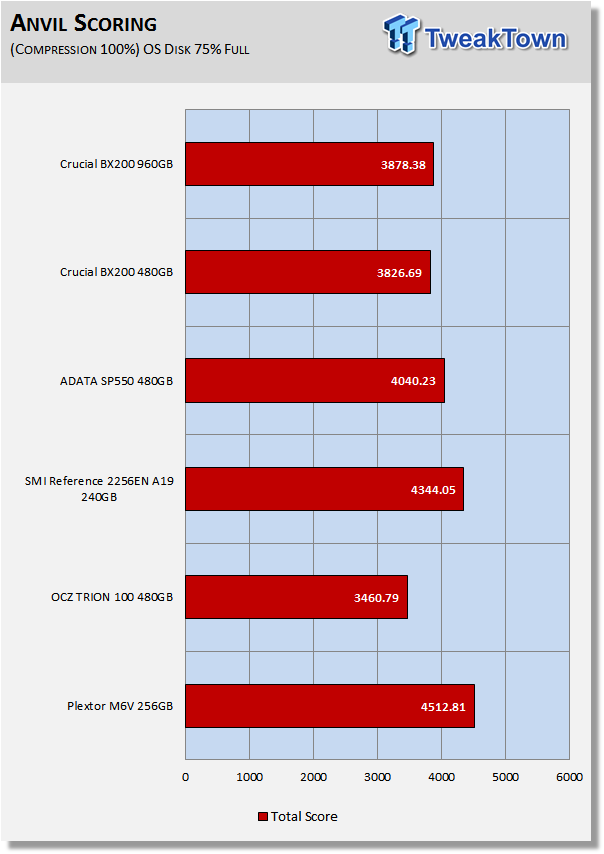
Anvil's scoring gives a good indication of a drive's overall performance. The BX200 performs better than OCZ's TRION 100, but below that of the rest of the drives in our test pool.
(Anvil) Read IOPS through Queue Depth Scale
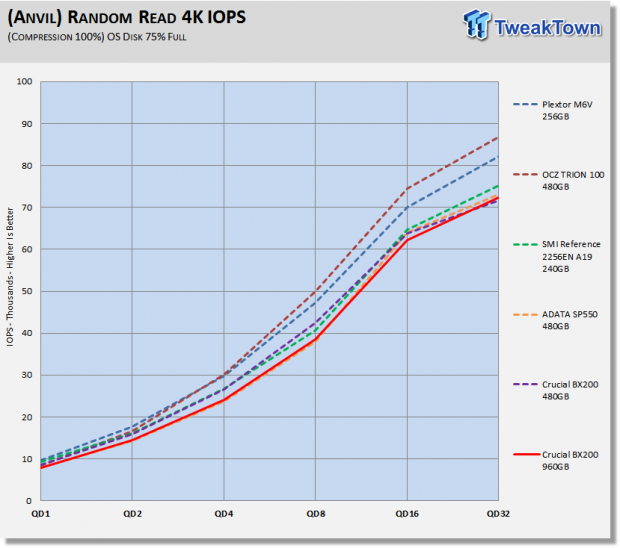
For the most part, the 480GB BX200 outperforms ADATA's SP550. The 960GB BX200 battles it out with the SP550 for the lowest performance on our chart.
(Anvil) Write IOPS through Queue Scale
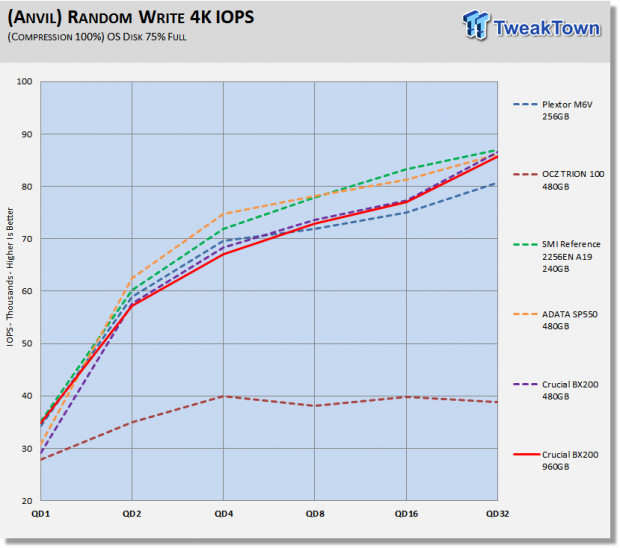
Both BX200's outperform the TRION 100 but are easily outperformed by the SP550 and SMI reference design. It is important to keep in mind that this test fits within the drive's caching layer; sustained performance is actually much lower.
Synthetic Benchmarks - CrystalDiskMark & AS SSD
CrystalDiskMark
Version and / or Patch Used: 3.0 Technical Preview
CrystalDiskMark is disk benchmark software that allows us to benchmark 4k and 4k queue depths with accuracy. Note: Crystal Disk Mark 3.0 Technical Preview was used for these tests since it offers the ability to measure native command queuing at QD4.
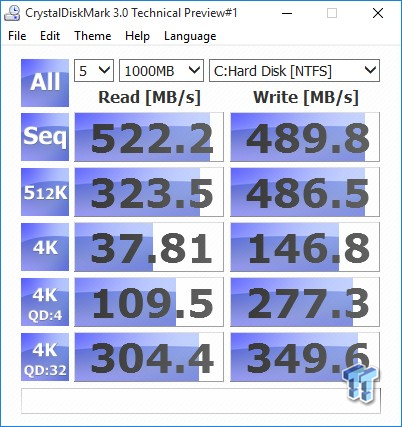
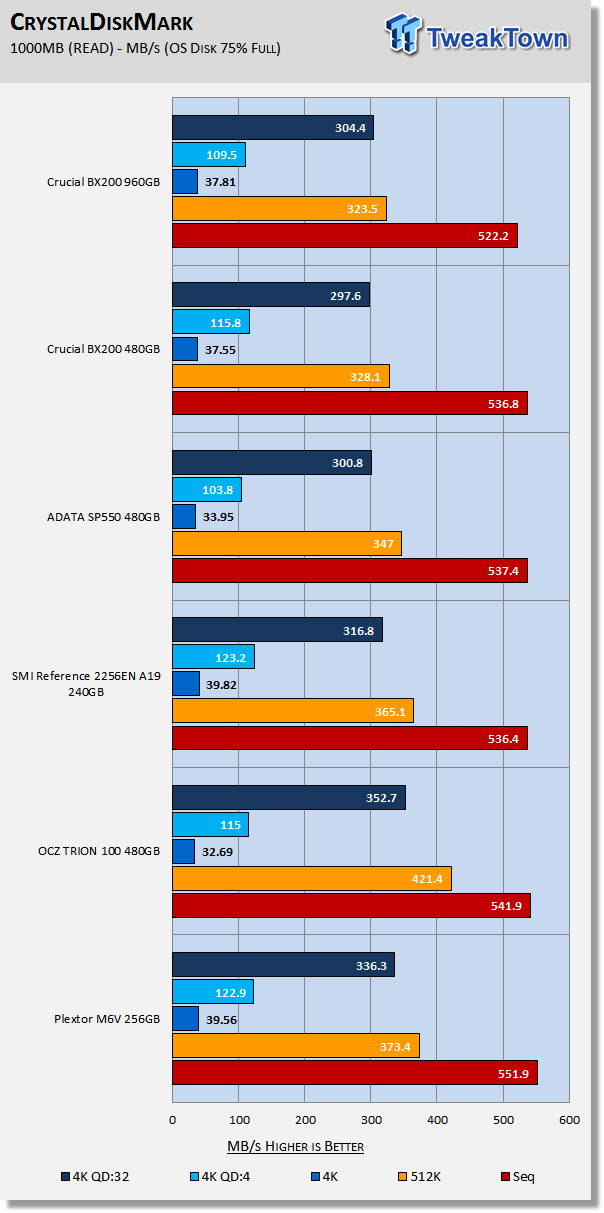
The BX200 displays decent 4k read performance, third to that of our SMI reference drive and the M6V. The remainder of the chart finds the BX200 performing below that of the rest of the drives in our test pool.
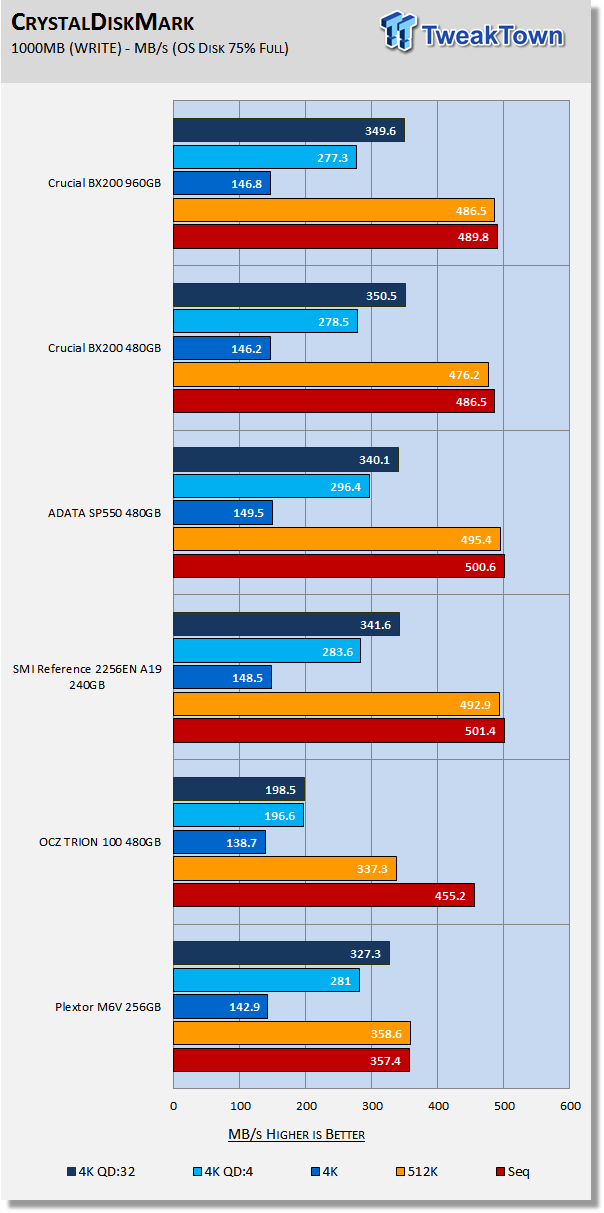
The BX200's caching layer is doing its job, enabling the BX200 to crank out some decent numbers across the board, especially at QD32.
AS SSD
Version and / or Patch Used: 1.7.4739.38088
AS SSD determines the performance of Solid-State Drives (SSD). The tool contains four synthetic as well as three practice tests. The synthetic tests are to determine the sequential and random read and write performance of the SSD.
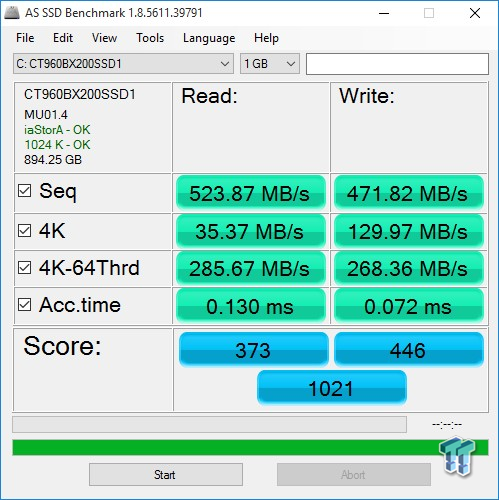
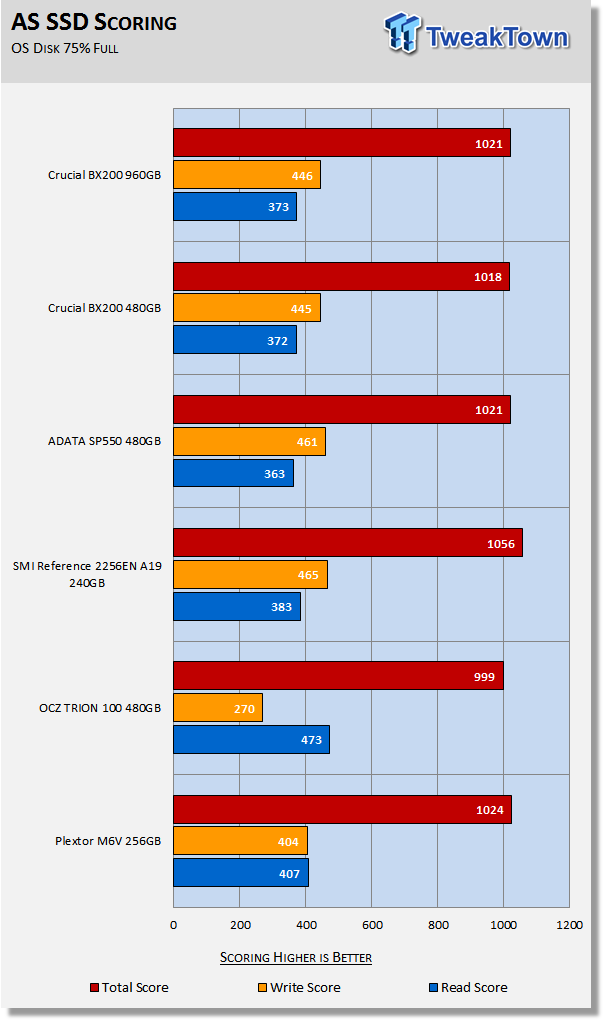
Scoring again looks decent - over a thousand points for both capacities. Again we will point out that this test is running within the drive's caching layer. Let's see what moderate workload performance looks like.
Benchmarks (Trace-Based OS Volume) - PCMark Vantage, PCMark 7 & PCMark 8
Moderate Workload Model
We categorize these tests as indicative of a moderate workload environment.
PCMark Vantage - Hard Disk Tests
Version and / or Patch Used: 1.2.0.0
The reason we like PCMark Vantage is because the recorded traces are played back without system stops. What we see is the raw performance of the drive. This allows us to see a marked difference between scoring that other trace-based benchmarks do not exhibit. An example of a marked difference in scoring on the same drive would be empty vs. filled vs. steady state.
We run Vantage three ways. The first run is with the OS drive 75% full to simulate a lightly used OS volume filled with data to an amount we feel is common for most users. The second run is with the OS volume written into a "Steady State" utilizing SNIA's guidelines. Steady state testing simulates a drives performance similar to that of a drive that been subjected to consumer workloads for extensive amounts of time. The third run is a Vantage HDD test with the test drive attached as an empty, lightly used secondary device.
OS Volume 75% Full - Lightly Used
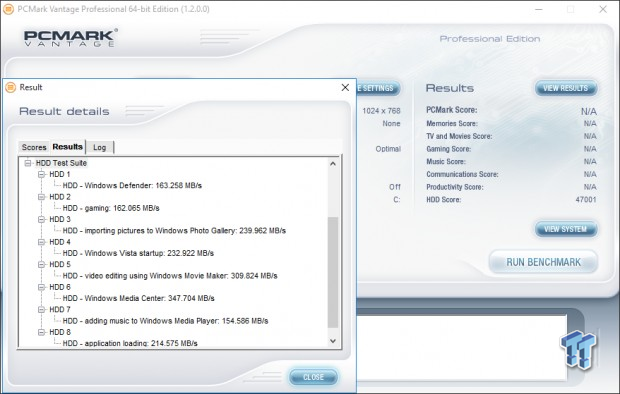
OS Volume 75% Full - Steady State
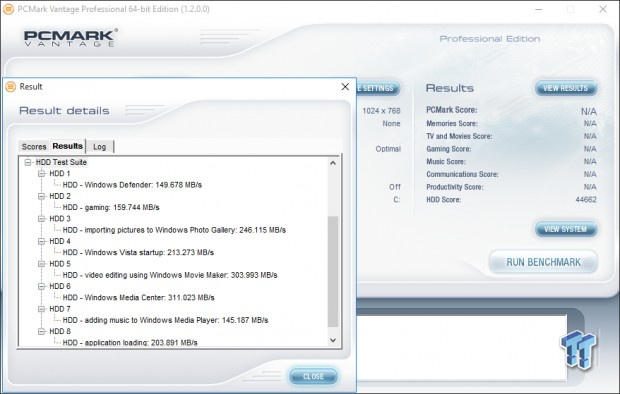
Secondary Volume Empty - FOB
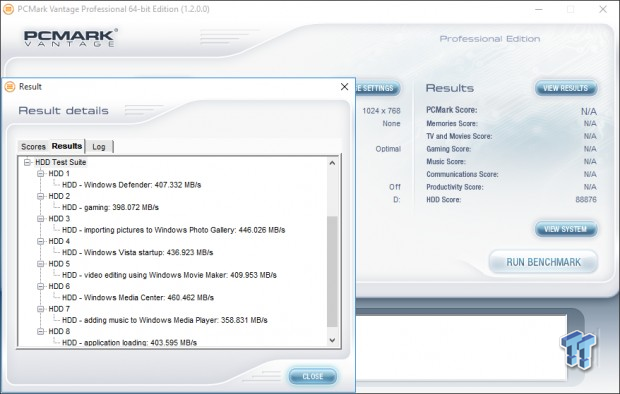
There's a big difference between an empty drive, one that's 75% full/used, and one that's in a steady state.
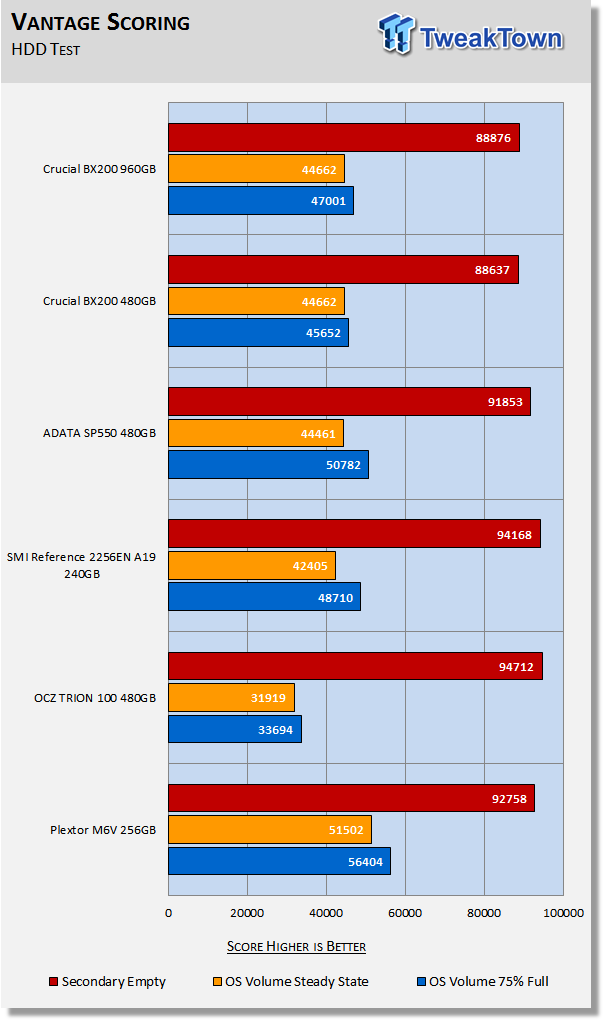
The important scores to pay attention to are "OS Volume Steady State" and "OS Volume 75% full." These two categories are most important because they are indicative of typical of consumer user states. When a drive is in a steady state, it means garbage collection is running at the same time it's reading/writing. This is exactly why we focus on steady state performance.
Empty secondary scoring is almost meaningless, so let's focus on steady state performance. The BX200 performs quite well against its peers, defeating all but the MLC-powered M6V.
PCMark 7 - System Storage
Version and / or Patch Used: 1.4.0
We will look to Raw System Storage scoring for an evaluation because it's done without system stops and, therefore, allows us to see significant scoring differences between drives.
OS Volume 75% Full - Lightly Used
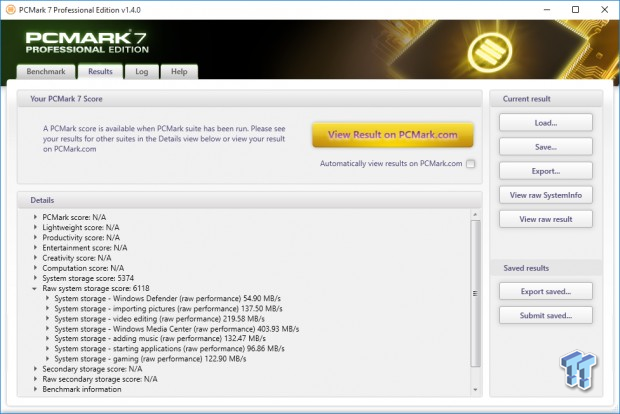

This portion of our testing finds the BX200 handily outperformed by all but the TRION 100.
PCMark 8 - Storage Bandwidth
Version and / or Patch Used: 2.4.304
We use PCMark 8 Storage benchmark to test the performance of SSDs, HDDs, and hybrid drives with traces recorded from Adobe Creative Suite, Microsoft Office, and a selection of popular games. You can test the system drive or any other recognized storage device, including local external drives. Unlike synthetic storage tests, the PCMark 8 Storage benchmark highlights real-world performance differences between storage devices.
OS Volume 75% Full - Lightly Used
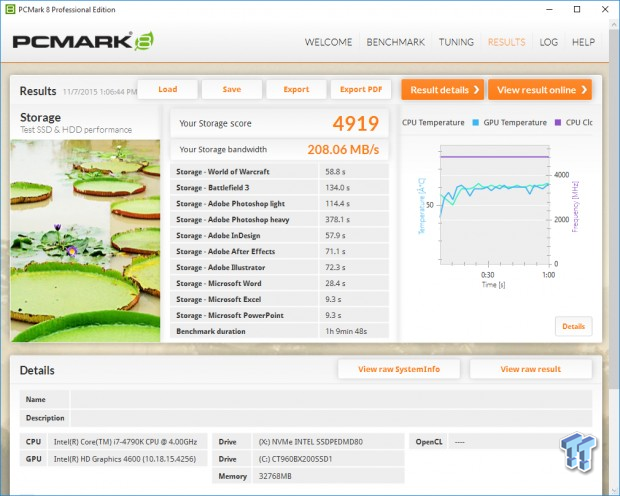
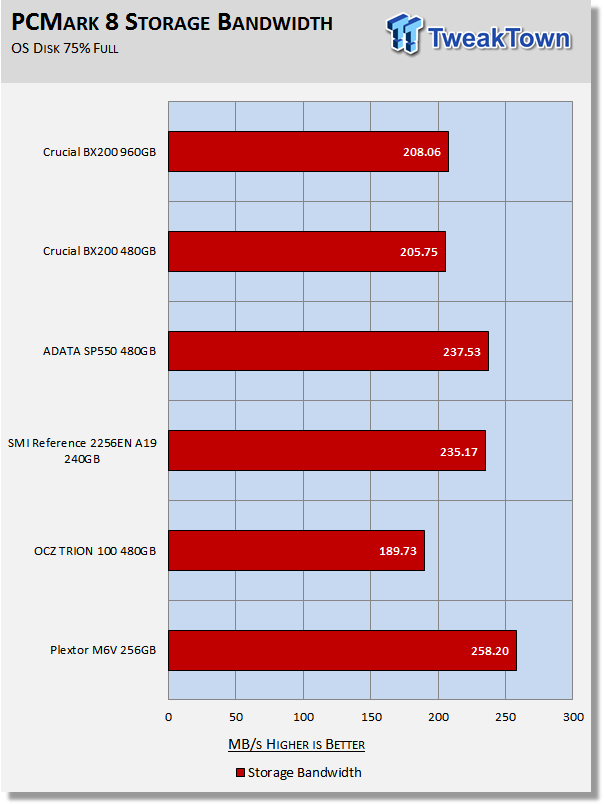
PCMark 8 is the most intensive moderate workload simulation we run. With respect to moderate workloads, this test is what we consider the best indicator of a drive's performance. Once again the BX200 is handily outperformed by all but the TRION 100.
Benchmarks (Secondary Volume) – Max IOPS, Disk Response & Transfer Rates
Iometer – Maximum IOPS
Version and / or Patch Used: Iometer 2014
We use Iometer to measure high queue depth performance. (No Partition)
Max IOPS Read

Max IOPS Write

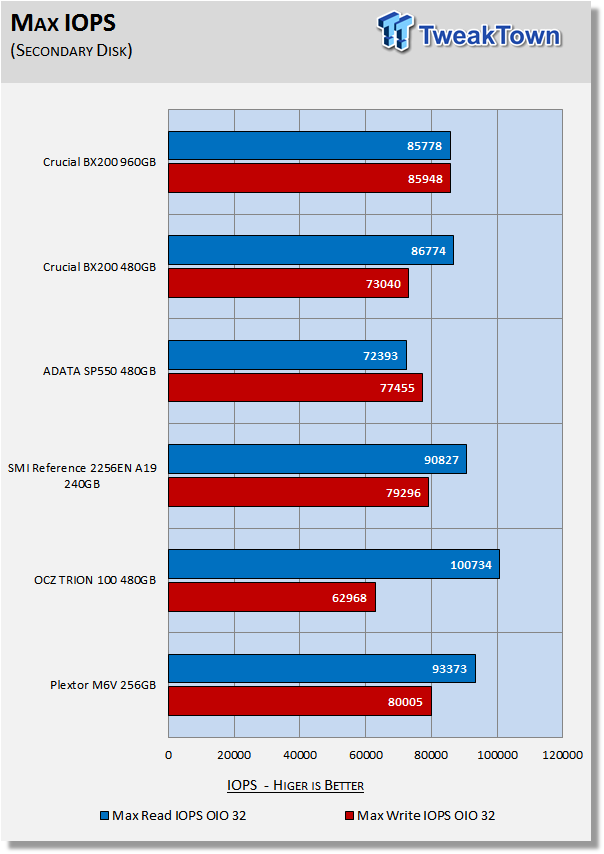
The 960GB BX200 delivers the best write performance of the test pool. Read performance is better than that of the SP550, but below the rest of the drives on our chart.
Iometer – Disk Response
Version and / or Patch Used: Iometer 2014
We use Iometer to measure disk response times. Disk response times are measured at an industry accepted standard of 4K QD1 for both write and read. Each test runs twice for 30 seconds consecutively, with a 5-second ramp-up before each test. We partition the drive/array as a secondary device for this testing.
Avg. Write Response
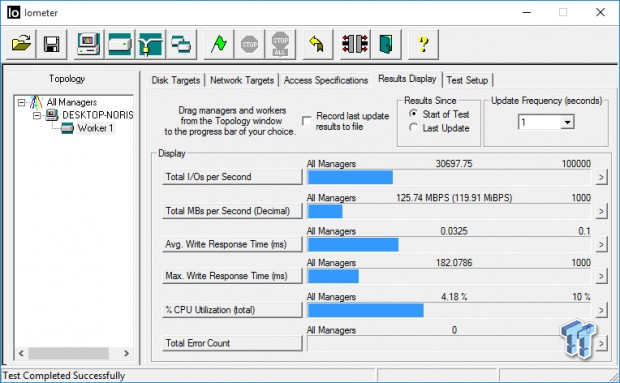
Avg. Read Response
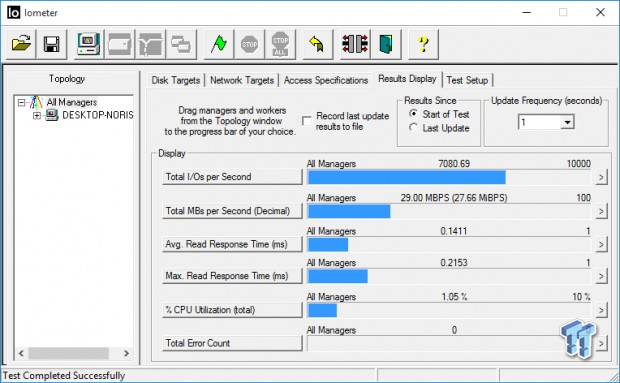
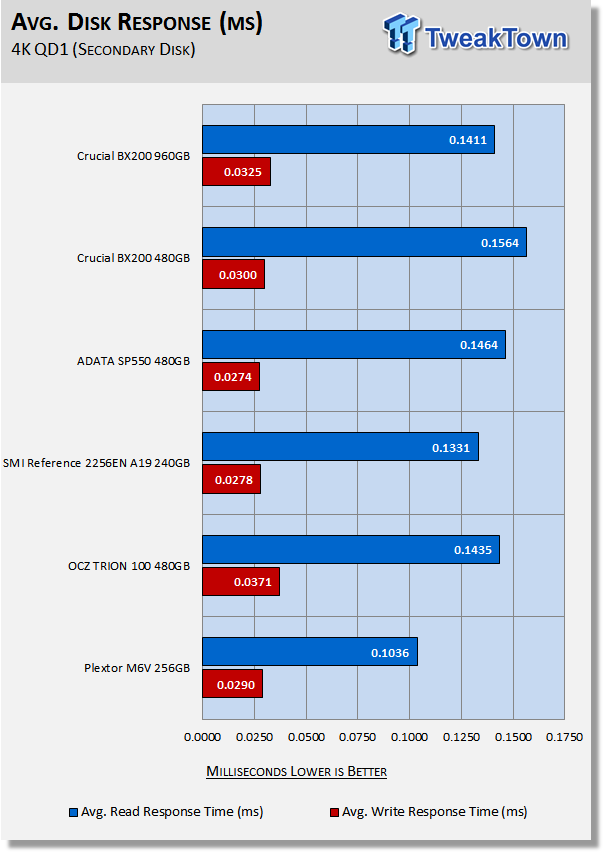
None of the drives in our test pool have very good response times, and the BX200 is no exception. The 480GB model has the highest read response times of the lot. Write latency isn't any better.
DiskBench - Directory Copy
Version and / or Patch Used: 2.6.2.0
We use DiskBench to time a 28.6GB block (9,882 files in 1,247 folders) composed primarily of incompressible sequential and random data as it's transferred from our DC P3700 PCIe NVME SSD to our test drive. We then read from a 6GB zip file that's part of our 28.6GB data block to determine the test drives read transfer rate. Our system is restarted prior to the read test to clear any cached data, ensuring an accurate test result.
Write Transfer Rate
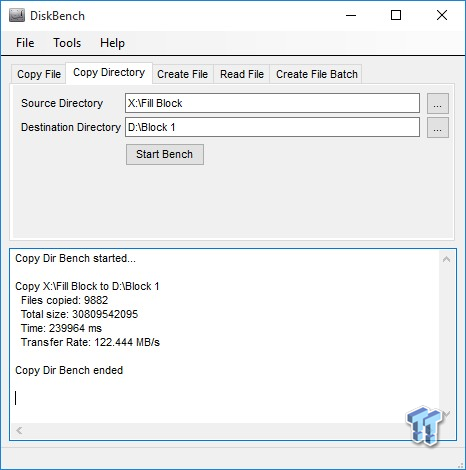
Read Transfer Rate
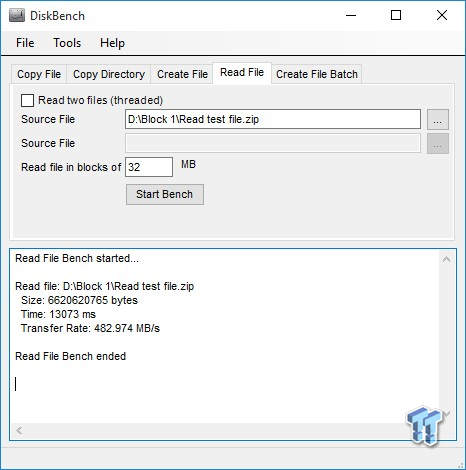
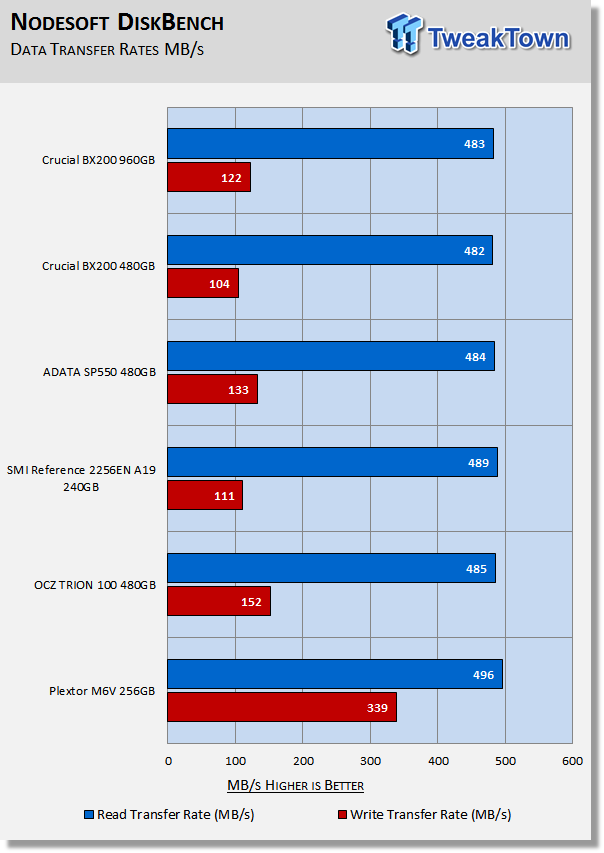
This is the unmasked write performance of Micron 16nm TLC flash. Like all non-Samsung TLC based drives we've tested to date, it is terrible. Plextor's M6V is the exception, and that's because it's MLC based.
Benchmarks (Secondary Volume) – PCMark 8 Extended
Futuremark PCMark 8 Extended
Heavy Workload Model
PCMark 8's consistency test simulates an extended duration heavy workload environment. PCMark 8 has built-in, command line executed storage testing. The PCMark 8 Consistency test measures the performance consistency and the degradation tendency of a storage system.
The Storage test workloads are repeated. Between each repetition, the storage system is bombarded with a usage that causes degraded drive performance. In the first part of the test, the cycle continues until a steady degraded level of performance has been reached. (Steady State)
In the second part, the recovery of the system is tested by allowing the system to idle and measuring the performance after 5-minute long intervals. (Internal drive maintenance: Garbage Collection (GC)) The test reports the performance level at the start, the degraded steady-state, and the recovered state, as well as the number of iterations required to reach the degraded state and the recovered state.
We feel Futuremark's Consistency Test is the best test ever devised to show the true performance of solid state storage in an extended duration heavy workload environment. This test takes on average 13 to 17 hours to complete and writes somewhere between 450GB and 14,000GB of test data depending on the drive. If you want to know what an SSDs steady state performance is going to look like during a heavy workload, this test will show you.
Here's a breakdown of Futuremark's Consistency Test:
Precondition phase:
1. Write to the drive sequentially through up to the reported capacity with random data.
2. Write the drive through a second time (to take care of overprovisioning).
Degradation phase:
1. Run writes of random size between 8*512 and 2048*512 bytes on random offsets for 10 minutes.
2. Run performance test (one pass only).
3. Repeat 1 and 2 for 8 times, and on each pass increase the duration of random writes by 5 minutes.
Steady state phase:
1. Run writes of random size between 8*512 and 2048*512 bytes on random offsets for 50 minutes.
2. Run performance test (one pass only).
3. Repeat 1 and 2 for 5 times.
Recovery phase:
1. Idle for 5 minutes.
2. Run performance test (one pass only).
3. Repeat 1 and 2 for 5 times.
Storage Bandwidth
PCMark 8's Consistency test provides a ton of data output that we use to judge a drive's performance.
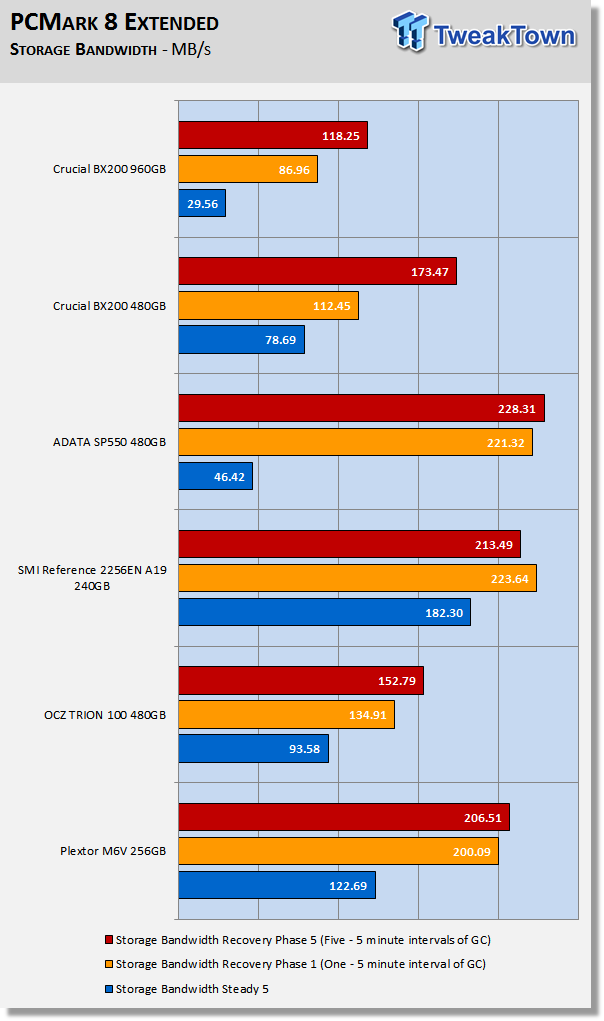
We consider steady state bandwidth (the blue bar) our test that carries the most weight in ranking a drive/arrays heavy workload performance. Performance after Garbage Collection (GC) (the orange and red bars) is what we consider the second most important consideration when ranking a drives performance. Trace-based steady state testing is where true high performing SSDs are separated from the rest of the pack.
Overall the BX200 delivers the worst performance we've seen while running this heavy duty test. The 960GB model has extreme difficulty digesting data generated by this test. It's very apparent that you do not want a BX200 if you run lengthy, heavy workloads. The SMI TLC-based reference board is the polar opposite, capable of delivering outstanding heavy workload performance.
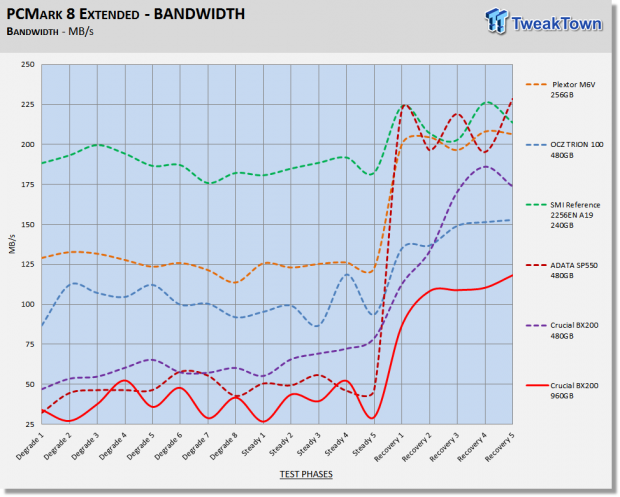
We chart our test subject's storage bandwidth as reported at each of the test's 18 trace iterations. This gives us a good visual perspective of how our test subjects perform as testing progresses. This chart sheds a little more light on how the drives perform as they progress through the testing phases.
Total Access Time (Latency)
We chart the total time the disk is accessed as reported at each of the test's 18 trace iterations. The BX200 spends way more time accessing data than the rest of the drives in our test pool.
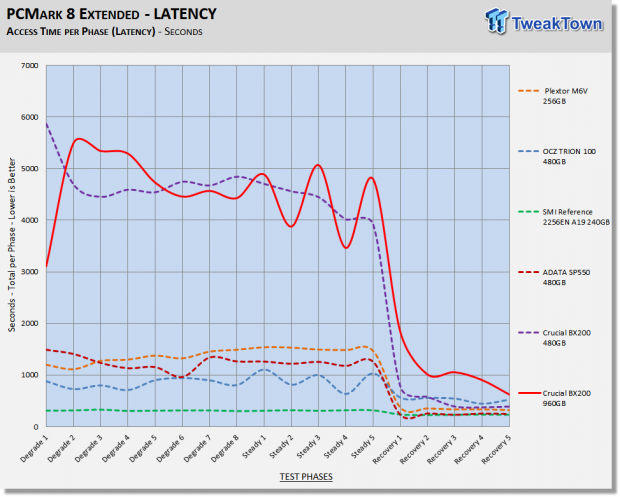
Disk Busy Time
Disk Busy Time is how long the disk is busy working. We chart the total time the disk is working as reported at each of the tests 18 trace iterations.
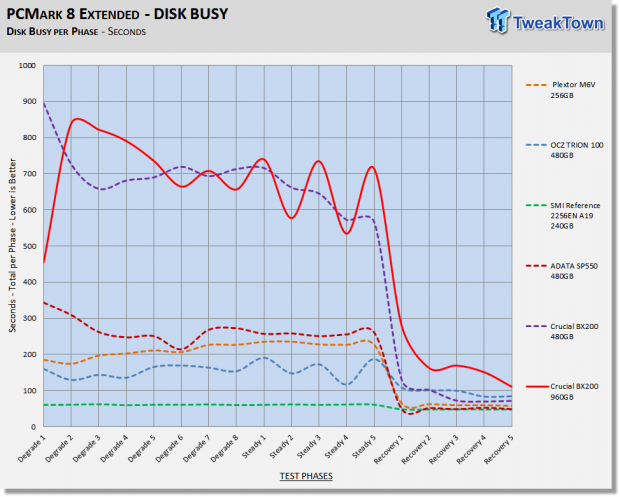
When latency is low, disk busy time is low as well.
Data Written
We measure the total amount of random data that our test drive/array is capable of writing during the degradation phases of the consistency test. Pre-conditioning data is not included in the total. The total combined time that degradation data is written to the drive/array is 470 minutes. This can be very telling. The better a drive/array can process a continuous stream of random data, the more data will be written.
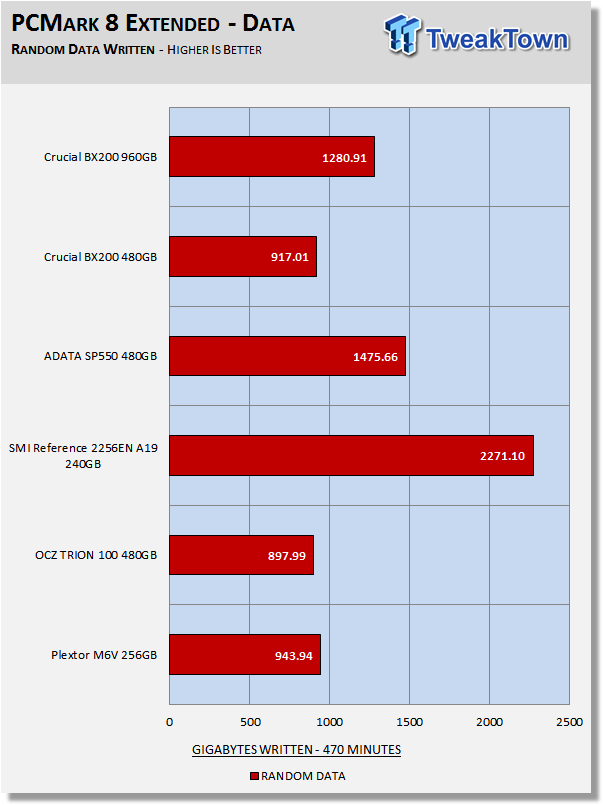
Combined read/write latency, capacity and overprovisioning are the biggest factors that determine the outcome of this portion of the test.
Benchmarks (Secondary Volume) – 70/30 Mixed Workload
70/30 Mixed Workload Test (Sledgehammer)
Version and / or Patch Used: Iometer 2014
Heavy Workload Model
This test hammers a drive so hard we've dubbed it "Sledgehammer". Our 70/30 Mixed Workload test is designed to simulate a heavy-duty enthusiast/workstation steady-state environment. We feel that a mix of 70% read/30% write, full random 4K transfers best represents this type of user environment. Our test allows us to see the drive enter into and reach a steady state as the test progresses.
Phase one of the test preconditions the drive for 1 hour with 128K sequential writes. Phase two of the test runs a 70% read/30% write, full random 4K transfer workload on the drive for 1 hour. We log and chart (phase two) IOPS data at 5-second intervals for 1 hour (720 data points). 60 data points = 5 minutes.
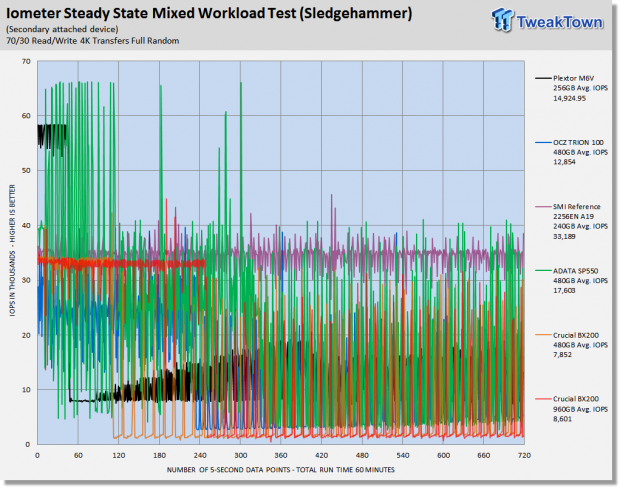
What we like about this test is that it reflects reality. Everything lines up, as it should. Consumer drives don't outperform Enterprise-Class SSDs that were designed for enterprise workloads. Consumer drives based on old technology are not outperforming modern Performance-Class SSDs, etc.
Even though this chart is very hard to read because of the performance variability common to SMI-powered drives, the BX200's are clearly delivering the lowest performance of the bunch.
Maxed-Out Performance (MOP)
This testing is just to see what the drive is capable of in an FOB (Fresh Out of Box) state under optimal conditions. We are utilizing Windows Server 2008 R2 64-bit for this testing. Same Hardware, just an OS change.
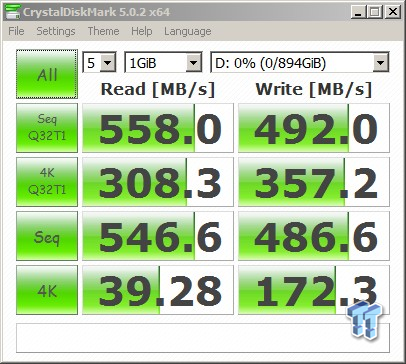
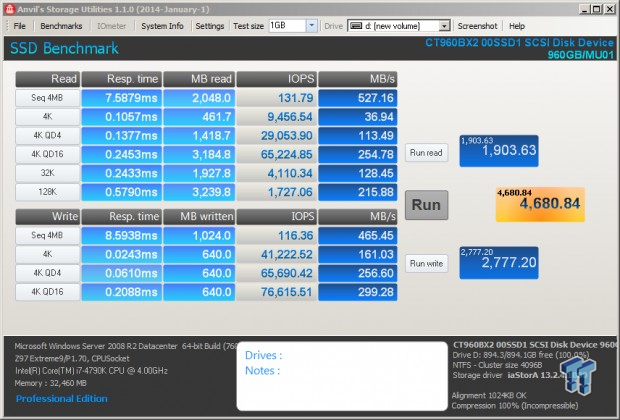
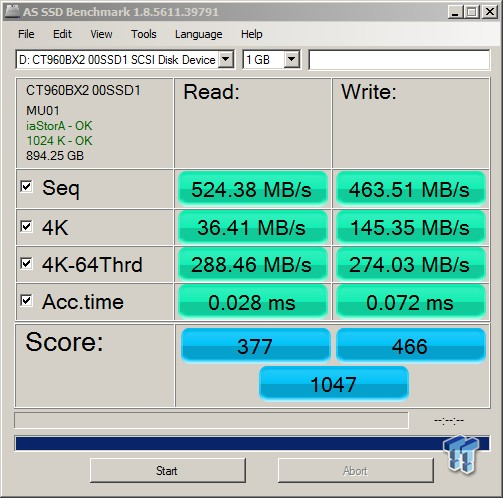
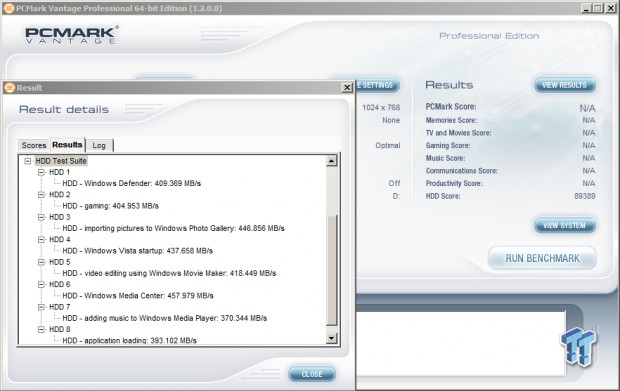
Final Thoughts
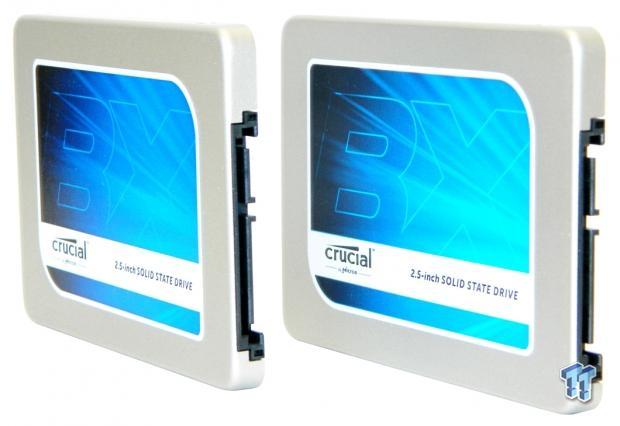
As viewed through the eyes of an enthusiast, Crucial's BX200 is not a very attractive option. It may be okay for gamers because it has excellent sequential read performance, but if you plan on transferring large chunks of data, or running moderate to heavy workloads, then this is not the drive for you. However, if you are a casual user, then the BX200 will serve you just fine - after all, it will give you a huge performance boost over a traditional HDD.
We are satisfied with the SSD experience that the BX200 delivers. For the most part, the BX200 performed okay while running as our OS disk. Boot times are decent. Programs load pretty fast. If you are upgrading from an HDD, then you will be pleasantly surprised. However, when comparing the BX200 to other SSDs on the market, the BX200 simply does not have compelling performance. At launch, the BX200 is about the lowest priced SSD on the market, but even then, we feel that the drive is overpriced for the performance you get.
Everything is trending toward TLC to bring about cost per gigabyte that will make solid state storage more mainstream. So far we are not liking what we are seeing. To date, only Samsung has delivered a TLC-based SSD that delivers enthusiast-grade performance. We hope to see that change in the near future, and we should as TLC moves to 3D.
Pros:
- Migration Software
Cons:
- High Latency
- Sustained Write Performance
- Overpriced
| Performance | 65% |
| Quality including Design and Build | 75% |
| General Features | 70% |
| Bundle and Packaging | 75% |
| Value for Money | 70% |
| Overall | 71% |
The Bottom Line: While the BX200 is much faster than an HDD, it does not deliver compelling performance. For the performance you get, we feel the BX200 is overpriced.
PRICING: You can find products similar to this one for sale below.
 United
States: Find other tech and computer products like this
over at Amazon.com
United
States: Find other tech and computer products like this
over at Amazon.com
 United
Kingdom: Find other tech and computer products like this
over at Amazon.co.uk
United
Kingdom: Find other tech and computer products like this
over at Amazon.co.uk
 Australia:
Find other tech and computer products like this over at Amazon.com.au
Australia:
Find other tech and computer products like this over at Amazon.com.au
 Canada:
Find other tech and computer products like this over at Amazon.ca
Canada:
Find other tech and computer products like this over at Amazon.ca
 Deutschland:
Finde andere Technik- und Computerprodukte wie dieses auf Amazon.de
Deutschland:
Finde andere Technik- und Computerprodukte wie dieses auf Amazon.de
What's in Jon's PC?
- CPU: AMD Ryzen 7800X 3D
- MOTHERBOARD: GIGABYTE AORUS Master X670E
- RAM: Kingston Fury Renegade 7200MHz 32GB
- GPU: ZOTAC AMP Extreme GeForce RTX 4090
- SSD: Crucial T700 2TB Gen5
- OS: Windows 11 Pro
- COOLER: Lian Li Galahad 360 AIO
- CASE: Lian Li Lancool III
- KEYBOARD: Corsair K65 RGB Mini
- MOUSE: SteelSeries AEROX 5 Wireless
- MONITOR: ASUS ROG Strix PG27AQN 360Hz 1440p ULMB2
Similar Content
Related Tags

